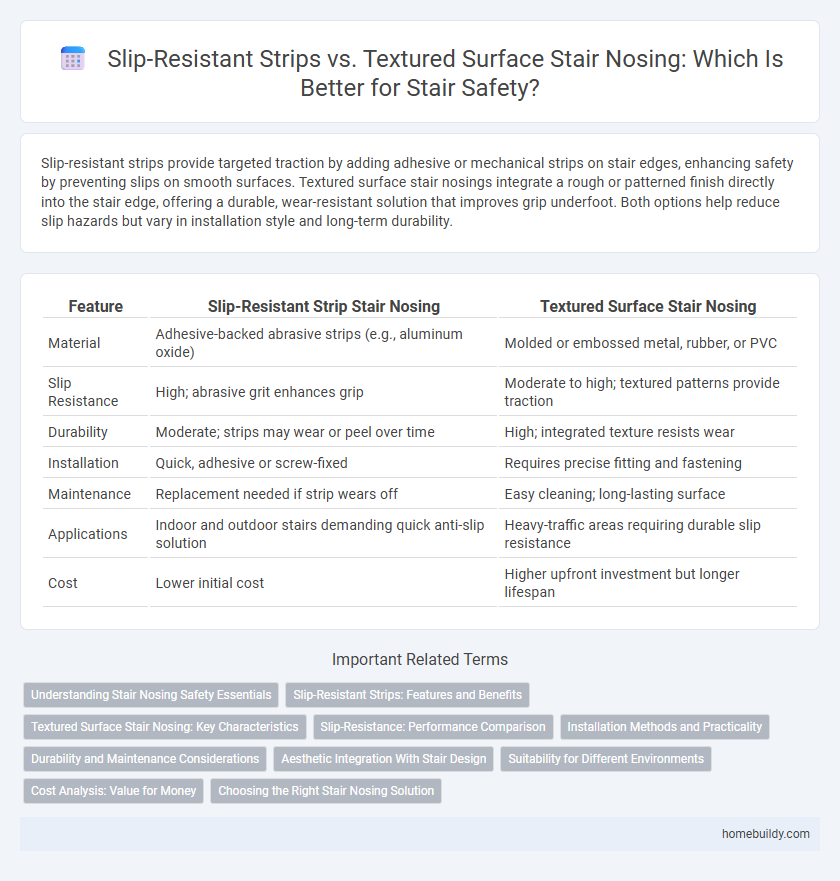Slip-resistant strips provide targeted traction by adding adhesive or mechanical strips on stair edges, enhancing safety by preventing slips on smooth surfaces. Textured surface stair nosings integrate a rough or patterned finish directly into the stair edge, offering a durable, wear-resistant solution that improves grip underfoot. Both options help reduce slip hazards but vary in installation style and long-term durability.
Table of Comparison
| Feature | Slip-Resistant Strip Stair Nosing | Textured Surface Stair Nosing |
|---|---|---|
| Material | Adhesive-backed abrasive strips (e.g., aluminum oxide) | Molded or embossed metal, rubber, or PVC |
| Slip Resistance | High; abrasive grit enhances grip | Moderate to high; textured patterns provide traction |
| Durability | Moderate; strips may wear or peel over time | High; integrated texture resists wear |
| Installation | Quick, adhesive or screw-fixed | Requires precise fitting and fastening |
| Maintenance | Replacement needed if strip wears off | Easy cleaning; long-lasting surface |
| Applications | Indoor and outdoor stairs demanding quick anti-slip solution | Heavy-traffic areas requiring durable slip resistance |
| Cost | Lower initial cost | Higher upfront investment but longer lifespan |
Understanding Stair Nosing Safety Essentials
Slip-resistant strip stair nosing incorporates abrasive materials such as aluminum oxide or silicon carbide to enhance traction on stair edges, minimizing the risk of slips and falls. Textured surface stair nosing features raised patterns or grooves designed to increase friction and provide tactile feedback underfoot, improving stability especially in wet or oily conditions. Both types are crucial in stair safety, with slip-resistant strips offering targeted grip and textured surfaces providing overall improved foot contact, aligning with OSHA and ADA safety standards.
Slip-Resistant Strips: Features and Benefits
Slip-resistant strips on stair nosing provide enhanced traction through high-friction materials such as abrasive grit or rubber, reducing slip hazards in both commercial and residential settings. These strips are often easy to install, highly durable, and comply with safety regulations like OSHA and ADA standards, ensuring safer stair use in wet or high-traffic areas. By improving foot grip and visibility, slip-resistant strips significantly decrease the risk of falls, making them an essential safety feature in stairway design.
Textured Surface Stair Nosing: Key Characteristics
Textured surface stair nosing features raised patterns or grooves that enhance traction, reducing the risk of slips on stairs. Its design often includes durable materials such as aluminum or rubber, providing long-lasting abrasion resistance and improved grip in high-traffic areas. This type of stair nosing is ideal for both indoor and outdoor applications where safety and durability are critical.
Slip-Resistance: Performance Comparison
Slip-resistant strip stair nosings offer targeted traction by incorporating abrasive materials such as aluminum oxide grit, enhancing safety on high-traffic areas prone to moisture and wear. Textured surface stair nosings utilize patterned or molded designs to provide uniform slip resistance across the entire stair edge, often improving grip without additional abrasive components. Performance comparisons show slip-resistant strips excel in extreme wet or oily conditions, while textured surfaces provide consistent all-around slip resistance with easier maintenance.
Installation Methods and Practicality
Slip-resistant strip stair nosing offers straightforward installation, typically requiring adhesive bonding or mechanical fastening directly onto stair edges, making it ideal for quick upgrades on existing stairs. Textured surface stair nosing involves more complex installation methods, often requiring precise fitting and securing with screws or nails to ensure durability and optimal traction on new or heavily trafficked staircases. Practicality-wise, slip-resistant strips provide a cost-effective, easy-to-replace solution for enhancing safety, while textured surface nosings deliver robust long-term performance suitable for commercial or high-usage environments.
Durability and Maintenance Considerations
Slip-resistant strip stair nosing offers enhanced durability due to materials like aluminum or rubber, which resist wear and tear while providing effective traction. Textured surface stair nosing, often made from molded composites or metal with patterned finishes, requires regular cleaning to maintain grip and can show wear faster in high-traffic areas. Maintenance for slip-resistant strips is generally lower since damaged strips can be replaced individually, whereas textured surfaces might need complete stair nosing replacement over time to ensure safety and appearance.
Aesthetic Integration With Stair Design
Slip-resistant strip stair nosing offers a sleek, minimalistic design that seamlessly blends with various stair materials, preserving the overall aesthetic harmony. Textured surface stair nosing provides a more pronounced tactile feel while complementing rugged or industrial stair designs, enhancing visual contrast. Both options improve safety but differ in their integration style, with slip-resistant strips favoring subtlety and textured surfaces emphasizing durability and character.
Suitability for Different Environments
Slip-resistant strips on stair nosing provide targeted traction ideal for indoor environments with moderate foot traffic and smooth flooring, enhancing safety without altering aesthetics. Textured surface stair nosing offers more aggressive grip suitable for outdoor or high-traffic areas exposed to moisture, dirt, and wear, ensuring durability under harsh conditions. Choosing between slip-resistant strips and textured surfaces depends on the environmental factors such as exposure to weather and user traffic intensity.
Cost Analysis: Value for Money
Slip-resistant strip stair nosings generally offer a cost-effective solution with targeted safety benefits, making them ideal for budget-conscious projects that require basic slip prevention. Textured surface stair nosings tend to have a higher upfront cost due to their durable materials and comprehensive coverage, providing enhanced safety and longevity that justify the investment over time. Evaluating value for money depends on weighing initial expenditures against maintenance needs and expected lifespan within specific high-traffic environments.
Choosing the Right Stair Nosing Solution
Slip-resistant strip stair nosing offers targeted traction through embedded materials like abrasive grit, ideal for high-traffic commercial spaces requiring enhanced grip on specific stair edges. Textured surface stair nosing provides a uniform tactile profile across the entire nosing, promoting consistent slip resistance in residential or light-use environments. Selecting the right stair nosing depends on factors such as foot traffic volume, environmental conditions, and compliance with safety regulations like OSHA and ADA standards.
Slip-resistant strip vs Textured surface stair nosing Infographic

 homebuildy.com
homebuildy.com